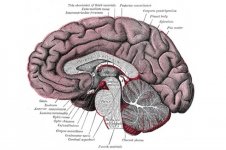David Baxter PhD
Late Founder
How Our Brains Got Their Wrinkles
by Janet Fang
August 20, 2014

Gray?s Anatomy via Wikimedia
Every new thing you learn makes a new wrinkle in the brain... at least that?s what we've been told all these years. Now, researchers examining how the exterior layer of our brains (the cerebral cortex) folds up say it?s because of a simple mechanical instability. The work was published in Proceedings of the National Academy of Sciences this week.
Brain wrinkles are comprised of strongly convoluted sulci (grooves) and gyri (ridges) -- these are what give the mammal brain, and the human brain especially, its large surface area to volume ratio. How convoluted they are is correlated with their information-processing capacity; on the other hand, a loss of folds could mean a loss of function.
Existing theories about how the brain's folds form include: more neurons migrating to the hills, making them rise above the valleys, and axons pulling the valleys down, New Scientist explains.
A team led by L. Mahadevan from Harvard modeled how the brain develops in the embryo using numerical simulations of a growing elastic medium, as well as physical models of the process using ?swelling? gels. The outer gray matter consists mostly of neuron bodies, while the white matter underneath consists mostly of axons, which are the extensions of neurons that allow them connect to each other. The researchers placed a layer of gel (for gray matter) on top of a solid hemisphere of gel (for white matter).
The iconic patterns, the team found, exist thanks to a mechanic instability that?s driven by the expansion of the gray matter and constrained by the white matter.
The resulting patterns are a function of two simple geometric parameters: cortical expansion and thickness relative to brain size. As the cortex expands, if it stays attached to the white matter below, it will physically buckle. "Once you have that, everything else follows," Mahadevan tells News Scientist. "It's an extremely simple mechanism."
Understanding variations that lead to smooth or cusped patterns could help with disorders such as polymicrogyria, lissencephaly, and pachygyria where the brain has too many folds, no folds, or only a few, flat ridges, respectively.
Here?s a video demonstrating the instability:
Read more at How Our Brains Got Their Wrinkles | IFLScience
by Janet Fang
August 20, 2014

Gray?s Anatomy via Wikimedia
Every new thing you learn makes a new wrinkle in the brain... at least that?s what we've been told all these years. Now, researchers examining how the exterior layer of our brains (the cerebral cortex) folds up say it?s because of a simple mechanical instability. The work was published in Proceedings of the National Academy of Sciences this week.
Brain wrinkles are comprised of strongly convoluted sulci (grooves) and gyri (ridges) -- these are what give the mammal brain, and the human brain especially, its large surface area to volume ratio. How convoluted they are is correlated with their information-processing capacity; on the other hand, a loss of folds could mean a loss of function.
Existing theories about how the brain's folds form include: more neurons migrating to the hills, making them rise above the valleys, and axons pulling the valleys down, New Scientist explains.
A team led by L. Mahadevan from Harvard modeled how the brain develops in the embryo using numerical simulations of a growing elastic medium, as well as physical models of the process using ?swelling? gels. The outer gray matter consists mostly of neuron bodies, while the white matter underneath consists mostly of axons, which are the extensions of neurons that allow them connect to each other. The researchers placed a layer of gel (for gray matter) on top of a solid hemisphere of gel (for white matter).
The iconic patterns, the team found, exist thanks to a mechanic instability that?s driven by the expansion of the gray matter and constrained by the white matter.
The resulting patterns are a function of two simple geometric parameters: cortical expansion and thickness relative to brain size. As the cortex expands, if it stays attached to the white matter below, it will physically buckle. "Once you have that, everything else follows," Mahadevan tells News Scientist. "It's an extremely simple mechanism."
Understanding variations that lead to smooth or cusped patterns could help with disorders such as polymicrogyria, lissencephaly, and pachygyria where the brain has too many folds, no folds, or only a few, flat ridges, respectively.
Here?s a video demonstrating the instability:
Read more at How Our Brains Got Their Wrinkles | IFLScience
